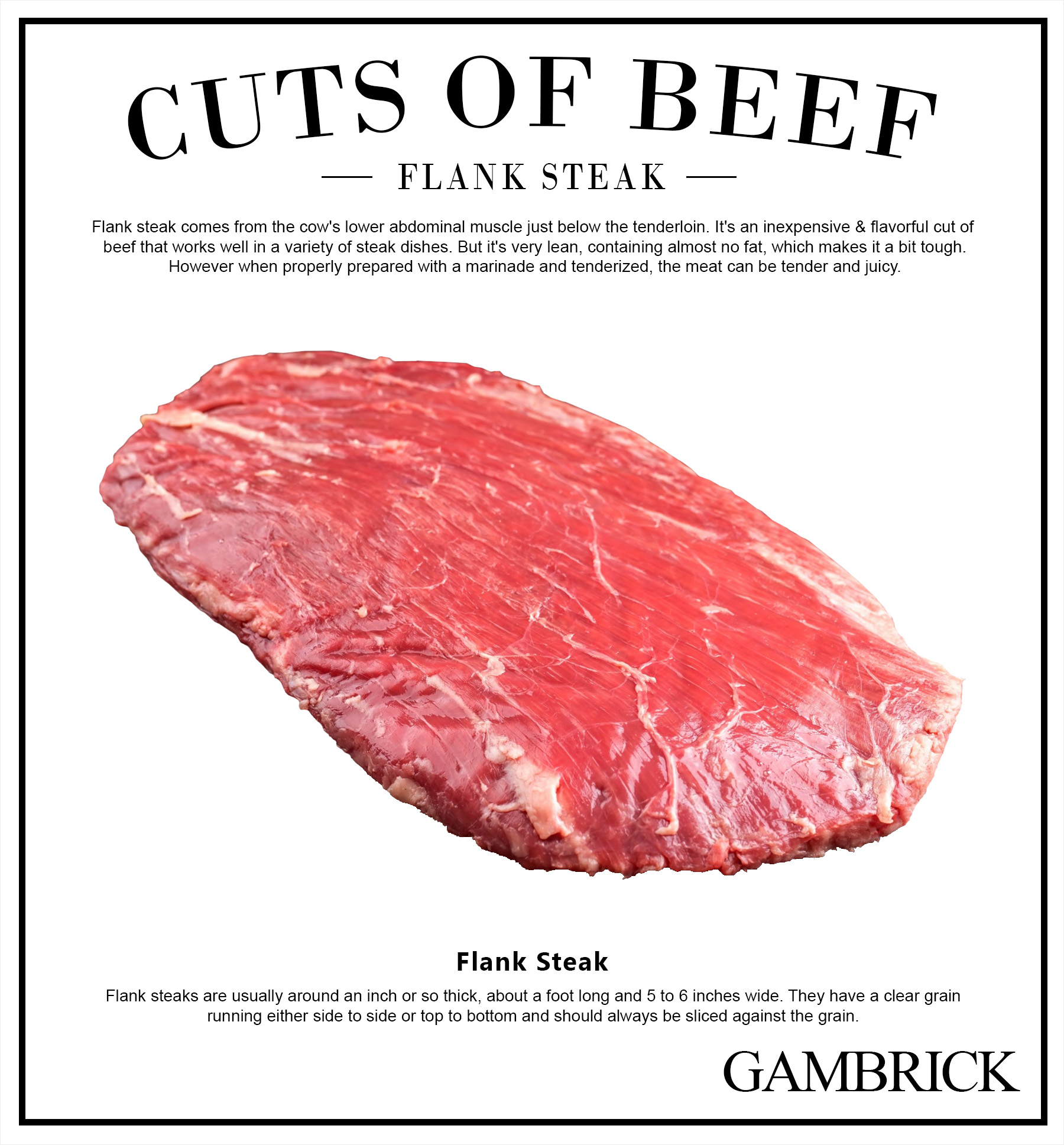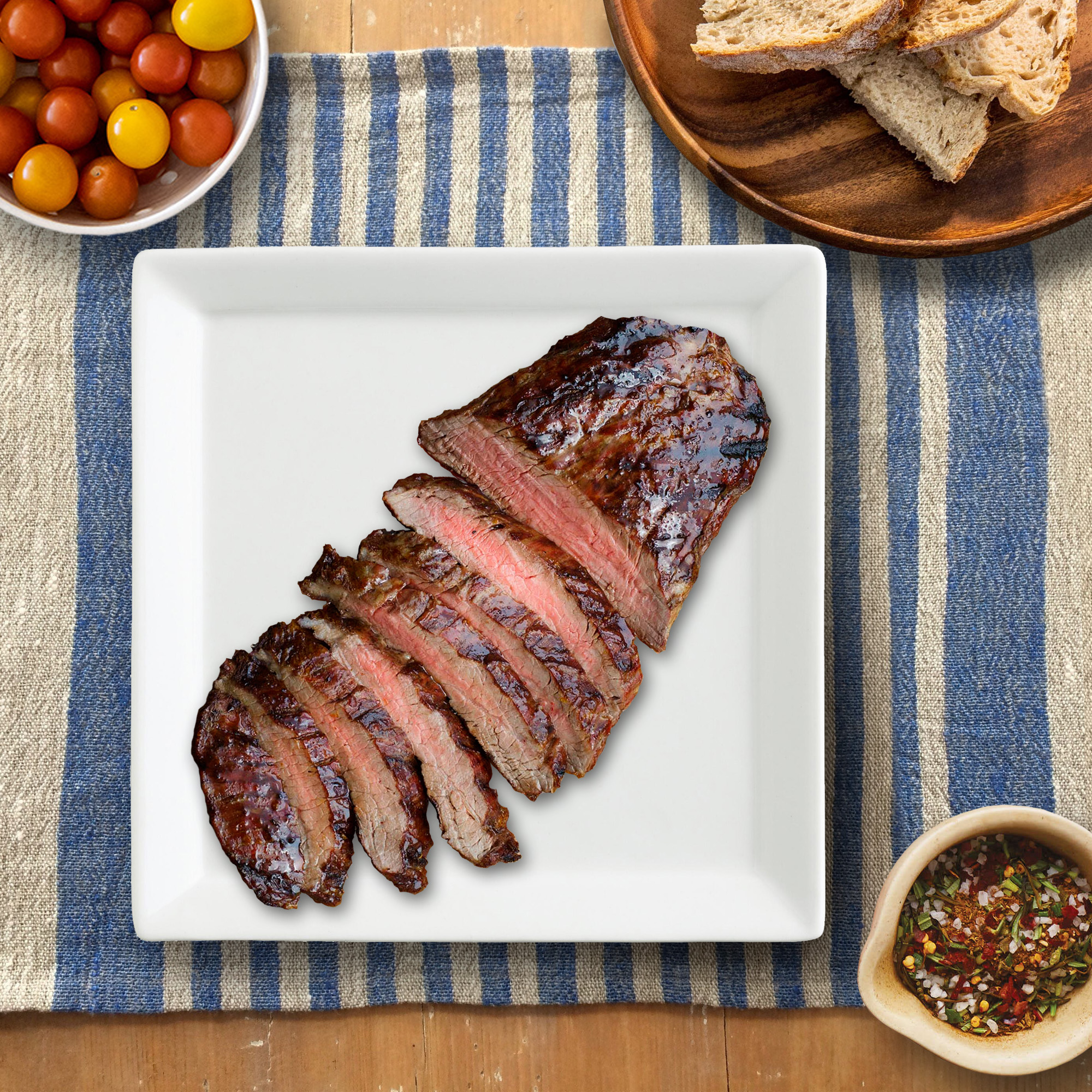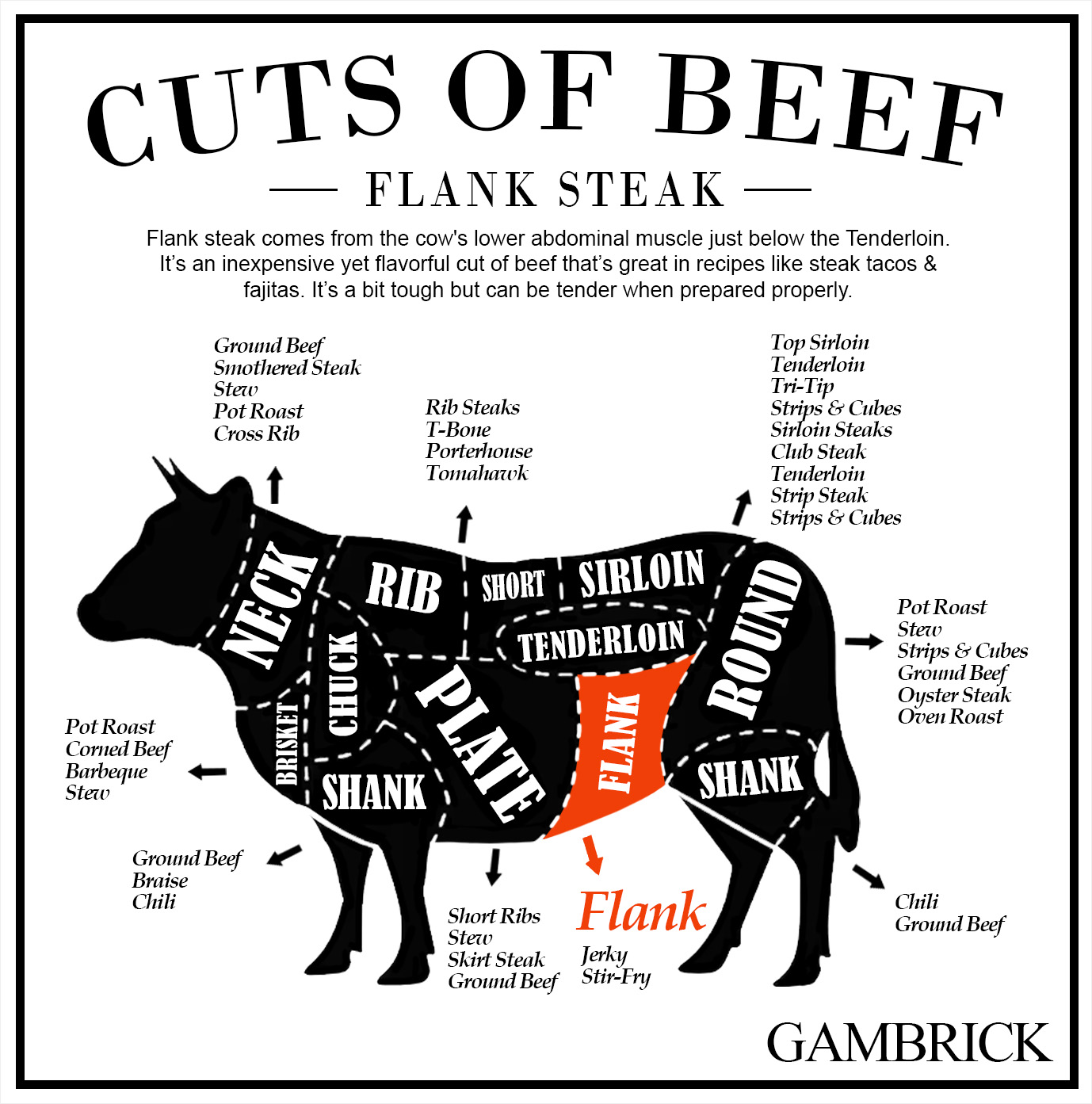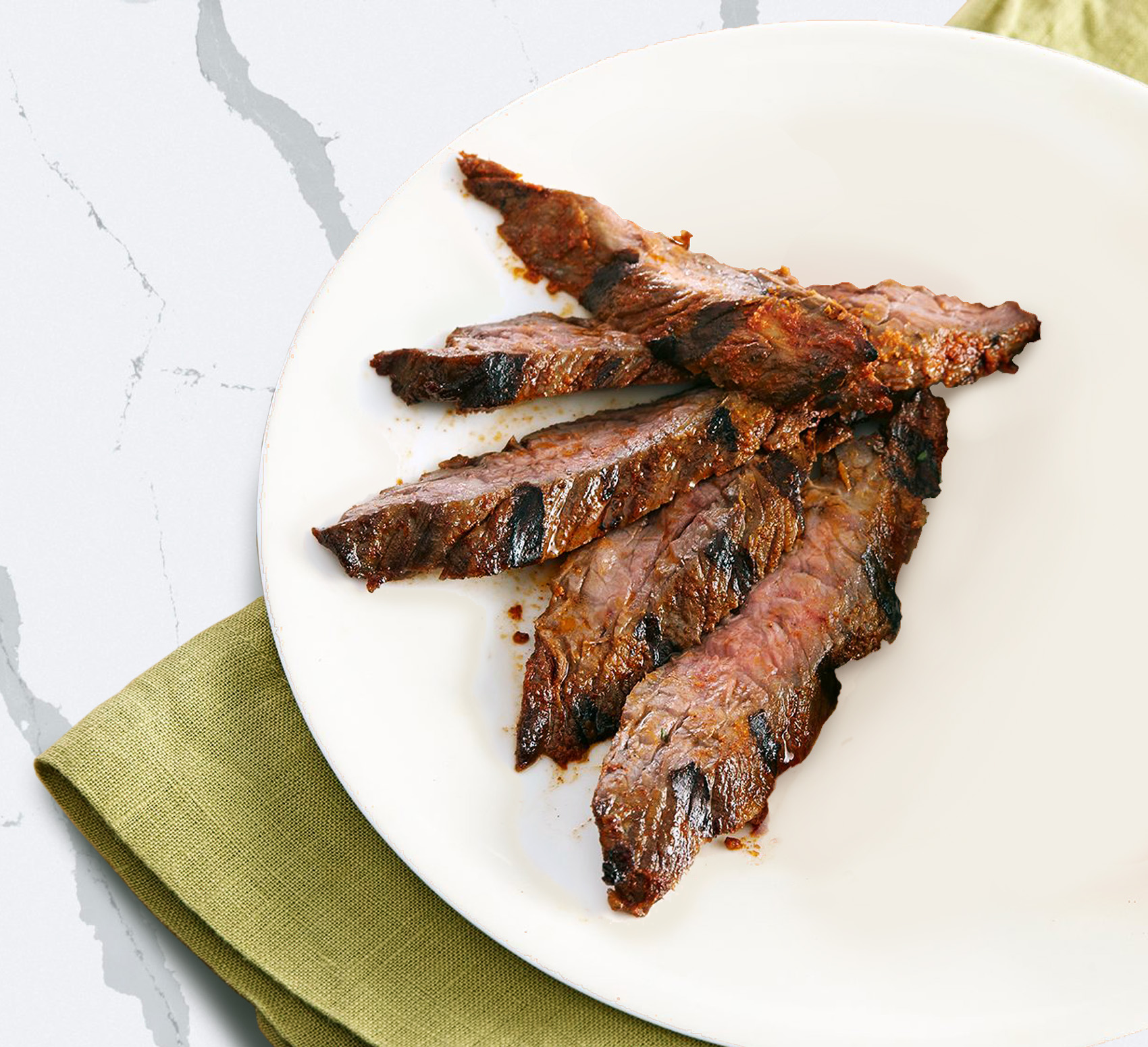What Is Flank Steak?
Flank steak comes from the cow’s lower abdominal muscle just below the tenderloin. It’s an inexpensive & flavorful cut of beef that works well in a variety of steak dishes. But it’s very lean, containing almost no fat, which makes it a bit tough. However when properly prepared with a marinade and tenderized, the meat can be tender and juicy. Flank steaks are usually around an inch or so thick, about a foot long and 5 to 6 inches wide. They have a clear grain running either side to side or top to bottom and should always be sliced against the grain. Because the beef is tough, it should be tenderized with a mallet or an acid based marinade or rubs that soften the meat.
Flank steaks are only about an inch thick so cook them either very fast on high heat or slow-braised in an oven. Try one in tacos, fajitas, with rice and beans, in a salad or over pasta. It has a great beef flavor that works in just about any steak dish.
If you cook flank like a traditional steak, season it with a generous amount of coarse salt and pepper and include some fats like olive oil or butter, because it doesn’t have any of its own. Serve it with vegetables or a sauce to add some moisture to the dish.
In restaurants, flank steaks aren’t sold on the menu because they’re not typically eaten like a traditional steak. The meat is generally sliced into thin slices and served as a steak dish. If you’ve ever ordered steak tacos, fajitas, stir-fry or a steak sandwich with peppers and onions, then you’ve most likely eaten flank.
Is Flank Steak A Good Steak?
Yes, flank steak is a very good and popular cut of beef. It’s generally served in thin slices as part of a beef dish like tacos, fajitas, Mongolian beef or carne asada. But it’s usually not eaten alone as a traditional steak dinner.
Flank is a flavorful piece of meat with a great beef flavor, but it’s very lean, containing almost no fat. So it needs to be properly prepared or it can be tough and chewy. Because of how thin and lean the meat is, it should either be cooked fast over a high heat flame or slow cooked in a dutch-oven.
Flank steak benefits from being tenderized with a mallet, marinating or rubs and is best enjoyed in thin strips cut across the grain.
If you cook flank like a traditional steak, season it with coarse salt and pepper and serve it with some vegetables, fries and a sauce. And add some fats like oil or butter when you cook it because it doesn’t have much fat of its own.
What Is Flank Steak Best Used For?
Flank steak is best used as part of a steak dish when sliced thin and either slow cooked on low heat or grilled quickly over a hot flame. It’s great for grilling, roasting, sauteing or my favorite, slow-braised in a dutch-oven.
Because flank is so lean, it can be dry and tough if overcooked. It’s important to cook flank to no more than medium and slice it very thinly against the grain. If you slice flank with the grain the meat will be chewy.
If you like steak more well done than medium, cook flank on low heat slowly in a dutch oven for 2 to 3 hours. Add a small amount of liquid to the pot and let it absorb into the meat. After a few hours flank steak will be tender enough to be cut with a fork.
Use flank steak in dishes like tacos, fajitas, carne-asada, a sandwich or Mongolian beef.
What’s The Best Cooking Method For Flank Steak?
The best cooking method for flank steak is either slow-braised on low heat in a dutch oven for 2 to 3 hours or grilled quickly over high heat. Because flank is so lean it’s easy to overcook the meat which makes it dry and chewy. If you cook it on the grill, take it off when it’s medium-well. Cook it any more and the center will dry out.
If you like your meat more well done, slow cook it on low heat in a dutch oven or pot. Cook it either on a stove top or in the oven with a small amount of liquid. Make sure the liquid is flavored correctly when you start braising because its flavor will absorb into the meat.
What’s A Flank Steak?
Flank steak is cut from the cow’s lower abdominal muscle just below the tenderloin. It helps the cow twist as it walks, so it gets a lot of exercise, which is why the meat is so lean and tough with clearly defined muscle fibers.
It’s a fairly inexpensive but flavorful steak that’s great when sliced thin and served in a steak dish. But it’s rarely eaten as a traditional steak dinner because it’s thin, lean and a bit tough.
- Flank steaks are about a foot long, 5 to 6 inches wide and about one inch thick.
- Flank steaks are cut from the flank of the cow just below the loin and sirloin.
- They’re generally sold whole rather than divided into smaller individual steaks.
- Flank is usually cooked and served in thin slices cut against the grain.
- Tough, lean cut that benefits greatly from a marinade or rub.
- Ideal for recipes that require beef strips.
- Best grilled over high heat or slow-braised.
- Eat it with fats like olive oil or butter because it doesn’t have it’s own fat.
- Always slice it against the grain to make it more tender.
- Flank steak can be identified by the visible direction of the meat’s cross-grain.
Flank steak is also known as jiffy steak, bavette (in French), and London broil. It’s often mistaken for a skirt steak because they look similar, but skirt is a different cut.
How To Cook Flank Steak
Flank steak is very flavorful and juicy when cooked the right way. But it’s easy to overcook because of how thin it is and it’s a but tough so marinades and some tenderizing are a good idea.
Because of flank steak’s low fat content, it doesn’t need to be trimmed before you cook it. Season it simply with a generous amount of coarse salt and pepper or your favorite meat rub.
To achieve the best flavor and texture, tenderize the meat before you cook it. Here’s how:
- Tenderize flank steak by hand with a meat tenderizing mallet
- Soak it in an acidic marinade
- Cover it in a tenderizing rub
- Try a soda cola bath
My favorite way to tenderize a flank steak is by slow cooking it on low heat in a marinade. Cooking the meat on low heat for a long time breaks down its tough connective tissue and naturally tenderizes it. The marinade also adds tons of flavor and juices to the meat.
You can slow cook flank steak either whole or sliced into thin strips. I prefer to do it in strips so more flavor soaks into the meat.
Flank steak is great for fajitas, stir-fries, tacos, sandwiches or with rice. Pretty much any recipe that calls for beef strips is ideal for flank steak.
Because of how low in fat flank steaks are, they’re best when you serve them with olive oil or some butter.
- Rest cooked steak for at least five minutes before serving.
- Slice them thinly against the grain, preferably at a 45-degree angle, for the best texture. Slicing with the grain makes them feel chewy.
Grill or sear flank steak on very high heat for a short period of time. They’re very thin and dry out easily so don’t over-cook them.
Grill Flank Steak On High Heat
Flank steak should be grilled on extremely high heat. It’s a very thin cut of beef so it’s easy to overcook the middle which dries it out. Sear the meat on a grill or in a skillet for just a few minutes on each side before slicing against the grain. Or cut the meat into thin slices before you grill and sear them in a hot skillet with some oil or butter.
Try not to grill flank past medium-rare or it will get chewy. If you want it more well-done, slow cook it in the oven instead of on a grill.
Let the steak rest for about ten minutes before slicing and eating it.
Here are some tips for preparing and cooking the meat:
- When you cut flank steak, make sure it’s across the grain. This will make the meat more tender. If you cut with the grain the meat will be chewy.
- When slicing, don’t hold your knife straight up and down like cutting bread. Instead, hold the knife at a 45-degree angle to make wider slices.
- Marinating the meat for 12 to 24 hours can help tenderize the meat while adding moisture and flavor. But it makes developing a crust near impossible.
Flank steak absorbs the flavor of whatever marinade or rub you use because it’s so thin. This is one of the reasons it’s such a versatile cut of beef that’s used in dozens of beef recipes all over the world.
Slow Braise Flank Steak On Low Heat
Braising is a low and slow cooking method that begins with dry heat and ends with moist heat. First, Brown the meat in a heavy-bottomed dutch oven with oil or butter on high heat to develop a crust (dry heat). Then cover and finish cooking in a liquid at lower temperatures (moist heat). Slow cooking can be done either on the stove-top or in an oven.
I usually slow cook flank for about 2 to 3 hours. Make sure the liquid and spices taste just right before you start cooking because their flavors will soak into the meat.
A slow cook time on low heat helps develop flavor and turns even the toughest of meat tender.
Here are a few ways you can braise flank:
- Sear the meat whole and then slow cook it. Slice after it’s done.
- Sear the beef whole, then slice it into pieces or strips before slow cooking.
- Cut the beef into pieces or strips before you sear.
I like to cut a flank steak into 4 to 5 chunks before I sear. Then I slice after the slow cook is done. This helps keep the inside moist.
- You can also try cutting slices of flank and pounding them very thin to tenderize. Then add a filling, roll and stick them with a toothpick and slow cook in a dutch-oven.
Although stir-frying flank is a great way to cook it, I like how tender it becomes when slow cooked. If you have the time for it, braising beef is a great way to make even the toughest cuts tender enough to cut with a fork.
What Does Flank Steak Taste Like?
Flank steaks have a strong beefy flavor. But because they’re so lean they lack the richness of more-marbled cuts of beef, which is why they’re typically eaten as part of a dish like tacos or fajitas, rather than as a traditional steak.
Since flank steaks are typically marinaded or covered with a rub to tenderize them, especially when grilled or slow-cooked, they take on the flavor of the rub or marinade. This can include citrus, fruit juices like orange and pineapple, cola, soy sauce, mustard, Worcestershire sauce, wine or other acidic or enzyme-rich ingredients used to tenderize the meat before cooking.
Flank steaks are typically served as part of a dish like tacos, stir-fry or fajitas, so they take on the flavors of whatever ingredients are used to spice the dish.
Because of how flank steaks are prepared and served, they’re one of the most versatile cuts of beef you can eat with a variety of flavors. The meat is used in Italian, Greek, Spanish, Asian, Latin and many other styles of cooking.
When cooked and eaten like a traditional steak, flank is best seasoned with a generous amount of coarse salt and pepper. Other ingredients like garlic, onions, tomatoes, oils, butter and vegetables can also be cooked with the meat to infuse it with a variety of flavors.
Flank steaks are very lean and about an inch thick which can make them a little chewy. However, when you slice them against the grain, tenderize them with a marinade, rub or mallet, and cook them properly, they’re tender and juicy.
Where To Buy Flank Steak
You can buy flank steak in most grocery stores, butchers, Walmart and Costco. Flank is a relatively cheap cut of beef that’s popular in many steak dishes so it’s not that hard to find.
Flank steak is sold by the pound and isn’t typically cut into individual steaks. A single steak can weigh between one and four pounds on average so the price can vary quite a bit.
Here are some tips to look for when buying Flank Steak:
- Flank is typically thicker on one end than the other. When you buy it, choose a steak that’s uniform in thickness to avoid overcooked ends.
- The meat tends to be a deeper red color than most other steaks.
- It will have long strands of muscle fiber running the length of the meat.
- The color should be deep red with no dark spots or brown discoloration. Brown color means the meat has been exposed to air for too long.
- There should be very little fat. Too much fat is a sign that it wasn’t trimmed properly.
- You may see a little bit of connective tissue on the thicker end.
You can also buy flank steak at many online meat sellers which will ship the beef to you in a freeze dried package.
How To Store Flank Steak
Store uncooked flank steak in the refrigerator at or around 35° F. Wrap it in butcher paper or keep it in the original supermarket packaging. Supermarket packaging is called “modified atmosphere packaging” for its carbon dioxide content, which helps preserve the meat for up to three days.
Cooked flank steak will keep in the refrigerator for up to four days at or around 35° F.
Flank steak can be frozen in its original packaging for 6 to 12 months. But vacuum-sealing will significantly increase that time and help prevent freezer burn.
What Is Flank Steak Called?
One of the most common names for flank steak is London Broil. However this is not always reliable because Top Round is also used to make London Broil. To determine if a steak marked London Broil is a Flank Steak, examine it’s thickness, size and texture. Flank is thinner than Top Round and has a more pronounced grain.
Here are a few other names Flank Steak also goes by:
- In French Flank Steak is called Bayette.
- Flank steak is called Arrachera in Spanish.
- Jiffy Steak
Flank is is a popular cut of beef around the world because it’s relatively cheap, flavorful and easy to cook. Cut it into thin slices against the grain and either fast cook it on high heat or slow cook it on low heat in the oven. It’s fantastic with marinades, rubs, sauces and in most beef dishes that require sliced meat.
Substitutes For Flank Steak
There are three cuts of beef that are very similar to flank steak, they’re called hanger, flat iron and skirt steak. All 3 cuts are similar in size, thickness, flavor and texture. And they all have a visible grain running though them which makes them ideal for slicing.
- Skirt steak is longer and thinner than flank. It comes from the diaphragm muscles of the cow and has a similar flavor a texture to flank. It’s a very popular cut of beef for steak tacos and Fajitas. It has a little more fat than flank which makes it juicier and more tender.
- Hanger steak resembles skirt steak more than flank. It’s long and thin with fat between the muscles. It’s nicknamed the “Butcher’s Cut” because butchers would historically take the steak home for themselves.
- Flat iron steaks are cut from a muscle near the shoulder blade. It may also be labeled as a petite tender or a top blade steak. It has a similar texture and flavor to flank and works well when thinly sliced.
If your recipe calls for flank steak but the grocery store doesn’t have it, any of these three cuts will work as a substitute. They all have a similar taste and texture, are great when marinaded or rubbed, and are best served thinly sliced.
Best Dishes For Flank Steak
The best way to cook flank steak is either quickly over high heat or slowly braised with low heat. Then slice the meat thinly against the grain and serve it as part of a steak dish like tacos or fajitas.
Marinade flank steak before cooking to both tenderize the meat and add lots of flavor. You can also use a tenderizing rub or a mallet to soften the meat’s tough muscle fibers before you cook.
The reason why you either cook flank fast with high heat or slow with low heat is how thin and lean the meat is. It’s very easy to overcook the inside which dries it out and makes the texture chewy.
Here are the best dishes you can make with flank steak:
- Tacos: Beef served with onions, peppers, cheese, tomatoes, salsa, sour cream, etc. in a tortilla.
- Fajitas: Sliced beef with peppers & onions.
- Carne Asada: Citrus marinaded steak with cilantro.
- Beijing Beef: Asian beef with red bell pepper & onions.
- Beef Stroganoff: Beef with mushrooms & cream sauce.
- Bistec Encebollado: Steak and onions from Puerto Rico.
- Stuffed Flank Steak: Thinly sliced beef rolled and stuffed.
- Pepper Steak: Thinly sliced meat flavored with black pepper.
- Mongolian Beef: Chunks of beef served in an Asian sauce served over vegetables and rice.
- Ropa Vieja: A true Cuban classic. Beef slow-cooked in tomato-wine sauce along with veggies until its tender enough to cut with a fork.
These are my 10 favorite dishes prepared with flank steak. But there are tons more you can try from all over the world.
Summary: What Is Flank Steak?
Flank steak comes from the cow’s lower abdominal muscle just below the tenderloin. It’s an inexpensive & flavorful cut of beef that works well in a variety of steak dishes. But it’s very lean, containing almost no fat, which makes it a bit tough. However when properly prepared with marinades and added fats, the meat can be made tender and juicy. Flank steaks are usually around an inch or so thick, about a foot long and 5 to 6 inches wide. They have a clear grain running either side to side or top to bottom and should always be sliced against the grain. Because the beef is tough, it benefits greatly from an acid based marinade or rubs which help soften the meat.
Flank steaks are only about an inch thick so cook them either very fast on high heat or slow-braised in an oven. Try one in tacos, fajitas, with rice and beans, in a salad or over pasta. It has a great beef flavor that works in just about any steak dish.
If you cook flank like a traditional steak, season it with a generous amount of coarse salt and pepper and include some fats like olive oil or butter, because it doesn’t have any of its own. Serve it with vegetables or a sauce to add some moisture to the dish.
In restaurants, flank steaks aren’t sold on the menu because they’re not typically eaten like a traditional steak. The meat is generally sliced into thin slices and served as a steak dish. If you’ve ever ordered steak tacos, fajitas, stir-fry or a steak sandwich with peppers and onions, then you’ve most likely eaten flank.
If you have any questions or comments about flank steak, email any time.

























